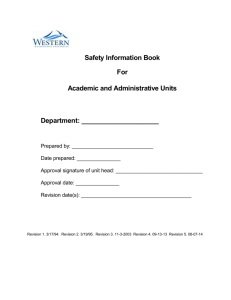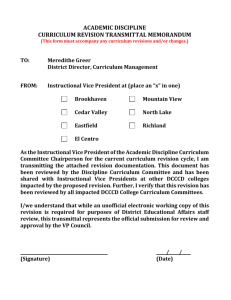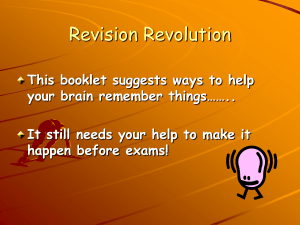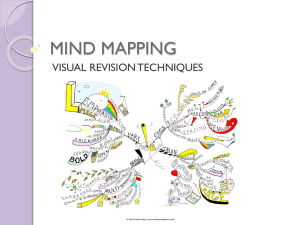6th Tamworth Group risk assessment January 2015
advertisement
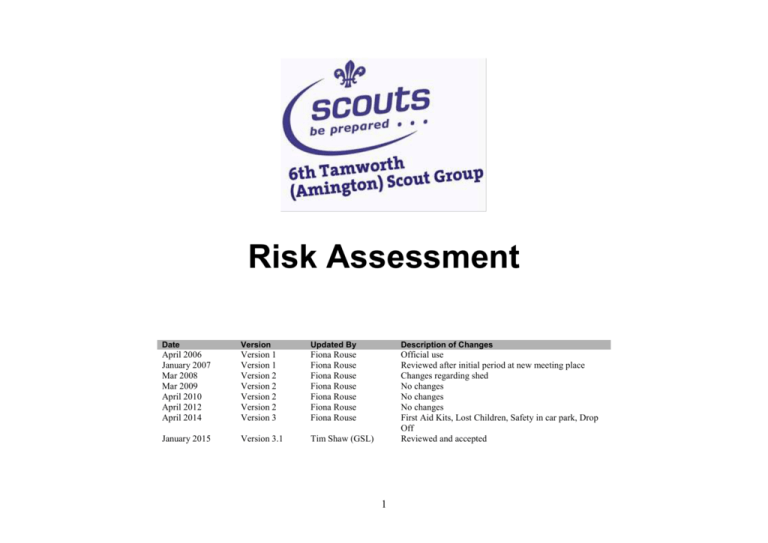
Risk Assessment Date Version Updated By Description of Changes April 2006 January 2007 Mar 2008 Mar 2009 April 2010 April 2012 April 2014 Version 1 Version 1 Version 2 Version 2 Version 2 Version 2 Version 3 Fiona Rouse Fiona Rouse Fiona Rouse Fiona Rouse Fiona Rouse Fiona Rouse Fiona Rouse January 2015 Version 3.1 Tim Shaw (GSL) Official use Reviewed after initial period at new meeting place Changes regarding shed No changes No changes No changes First Aid Kits, Lost Children, Safety in car park, Drop Off Reviewed and accepted 1 Risk assessments Meeting Place Risk Assessment HAZARD Trip and slip hazard WHO MIGHT BE HARMED All involved STEPS TO CONTROL RISK Electric Shock Individual Burn from contact with heating Individual Any spillages of food or drink to be cleared up as soon as possible (especially on non carpeted surfaces) Ensure vigilant for trailing cables etc. All areas to be kept as tidy as possible at all times Routine checking of toilet area to ensure floors clear of spills Out of bound areas (sports store, un supervised classrooms) clearly stated All mains sockets are checked to ensure either have plug fitted or switched off Adults to be vigilant for young people touching electricity sockets, power cables etc Heaters are of air blowing type and the casing does not get hot enough to inflict a burn Care should be taken in reception with new heater as dial can be accessed by young people 2 RISK LEVEL LOW Medium LOW REVIEW AND DECISION No further revision considered necessary at this time. No further revision considered necessary at this time. No further revision considered necessary at this time. HAZARD Injury obtaining equipment from shed WHO MIGHT BE HARMED Individual Group STEPS TO CONTROL RISK Allergies/ Asthma/ other Medical Conditions Child being lost Child not being brought into building Individual Individual Individual Scouts are not allowed in shed unsupervised Scouts and leaders should only attempt to lift items which they are capable of doing so Heavy or awkward items should not be stored high up Knives and other such sharp items should not be stored in the shed When collecting equipment/ storing equipment leader in charge should ensure adequate lighting Central space in shed to be kept clear at all times Torch should be available for use in shed Up to date Health Forms Ensure medication brought First Aid Kit to be brought in to each meeting. Contents of Kit should be checked for expiry All leaders should have minimum First Response Training Register on arrival External door on lock Regular head counts Reminders in Group Letter Reminders direct to parents Personal Letter 3 RISK LEVEL LOW REVIEW AND DECISION Lighting to be improved Floor spongey Shelving needs to be reviewed Check First Aid Kit expiry LOW Check expiry of Leaders qualifications Low MEDIUM Deal with cases individually Risk assessment for use of outside area for Activities hazard General injury hazards at the playing field Use of Play Equipment Who might be harmed All on activity Individual Group Children leaving site Individual Car Park Area Individual Steps to control risk Leaders should perform check of area to be used to ensure no easily visible hazards, if any found they will remove the hazard or select different area of playing field to use Visual check to ensure appears safe each time used. Check for underfoot conditions – slippy due to wet or moss etc. Reminder of safety rules each time used Register on arrival External gates closed Clear boundaries set Regular head counts Out of bounds unless with adult If being used for activity main gate should be closed and no traffic movement permitted. Zebra crossing used to cross over or use path around edge. Risk level Review and decision low ok Low Low Low Games to be played are normal games played in hall or in garden area by the relevant sections so no additional risk assessment is required for these 4 General Scout Activities Risk Assessment HAZARD Injury due to misuse of utensils or cooking equipment Fire or explosion due to Gas leak WHO MIGHT BE HARMED Individual Patrol STEPS TO CONTROL RISK Individual Patrol Food poisoning Individual Patrol Burns and scalds Individual Hypothermia (in cold weather all leaders should be aware and watch for signs of this) Individual Use of stoves and safety talks undertaken prior to any cooking activity. During food preparation, Leaders to monitor the food preparation Gas maintained in the ’off’ position at bottles when not in use. Specific order of actions for lighting of stoves provided during safety talk. Once cooking activities have been completed using gas appliances all gas bottles to be returned to shed correct food storage thorough cooking of foods high level of food and personal hygiene Leaders to check food is properly cooked before the young people eat. Leaders should monitor young people cooking where possible. no horseplay near cooking areas or fires ensure warm drinks available at all times if extended meeting time or activity ensure scouts have plenty of warm dry clothing 5 RISK LEVEL LOW REVIEW AND DECISION No further revision considered necessary at this time. No further revision considered necessary at this time. LOW LOW LOW No further revision considered necessary at this time. No further revision considered necessary at this time. No further revision considered necessary at this time. LOW HAZARD Tiredness or wet weather increase activity risk Injury from fire (e.g. burn) WHO MIGHT BE HARMED Individual Patrol Individual STEPS TO CONTROL RISK Axe injury Individual Injury from wood Individual The Leader in charge of the activity should assess if it can carry on if the weather changes. All fire areas are cordoned off, and are clear of any potential hazards identified and removed if possible prior to fire being lit. All fire areas are positioned away from natural games areas to segregate them as far as possible. Fire buckets are provided close to each fire. Group are provided with details of how to deal with burn injuries The dangers of putting aerosols and Gas canisters on the fire are provided during the safety talk Chopping areas are segregated, with only one person allowed in at any one time. Chopping areas are positioned away from overhanging trees or naturally occurring trip hazards. Only those wearing suitable boots are able to use a hand axe (from the standing position) or a felling axe. All use of axes in the chopping area is under Leader supervision unless specifically authorised otherwise. Eye protection to be worn when chopping wood whenever possible The dangers of handling wood (e.g. 6 RISK LEVEL LOW REVIEW AND DECISION No further revision considered necessary at this time. No further revision considered necessary at this time. LOW No further revision considered necessary at this time. LOW LOW No further revision HAZARD WHO MIGHT BE HARMED STEPS TO CONTROL RISK splinters) and the danger of wood piles (e.g. nails) to be provided during safety talk 7 RISK LEVEL REVIEW AND DECISION considered necessary at this time. Medical and Emergency Risk Assessment HAZARD Sun / heat exhaustion WHO MIGHT BE HARMED Parents wish to contact Scout/Leaders Individual Incident requiring first aid Individual Patrol Entire group Hospitalisation Individual Patrol Entire group STEPS TO CONTROL RISK RISK LEVEL Group are reminded of the need to wear suitable clothing and sun protection Group are reminded of the need to drink plenty of fluids especially when undertaking strenuous activities. Leader’s mobile phone numbers to be given to parents. Printed contacts to be available at all times Leaders have First Response, or better, certification Full first aid kit retained on site Minor injuries unit at Robert Peel Hospital Good Hope Hospital located at Sutton Coldfield for A&E Mobile telephones have good signals from the hall Sufficient Leaders on site to both attend hospital and run programme. Mobile telephones have good signals from hall Emergency contact details to be on site during activities Any necessary extra activity permission forms are completed before activity commences 8 REVIEW AND DECISION No further revision considered necessary at this time. LOW No further revision considered necessary at this time. No further revision considered necessary at this time. LOW No further revision considered necessary at this time. LOW


